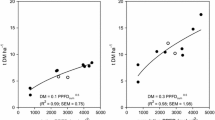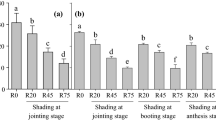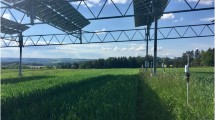Abstract
Shade cloth is commonly used in agroforestry research. It produces a continuous, uniform reduced light environment. Shade cloth and a slatted structure were compared in relation to the inability to represent the light regime and plant responses of an agroforestry system. The split-split-plot randomised block experiment had main plots as covering status (with or without radiata pine trees), subplots as artificial shade (none, shade cloth or wooden slats) and sub-subplots as growth rotation, over sown alfalfa, in three replicates. The quantity of light transmittance was 49% under trees, 41% under cloth and 44% under slats. Temporal changes and spectral composition under trees were more accurately reproduced under the slats than shade cloth. The red to far red ratio was 0.64 under tree shade and 0.74 during the shaded period under slats. This compared with 1.31 in open pasture, 1.28 under shade cloth in open and 1.26 under slats during sunny periods. To compensate for low light quantity and quality, alfalfa had elongated stems and internodes. In open pasture and under cloth in the open, it produced short stems. The mean dry matter yield under trees was 68% of the 30.3 t ha−1 in open pasture, 56% under cloth and 57% under slats. The slats induced similar morphological responses in alfalfa to those in the agroforestry system. The magnitude of changes had little effect on growth and yield responses. The artificial slatted structure approximated the intermittent light environment and consequent plant responses observed in an agroforestry system.








Similar content being viewed by others
References
Baldwin CM (2009) Impacts of altered light spectral quality on warm-season turfgrass growth under greenhouse conditions. Crop Sci 49:1444–1453
Belesky DP, Neel JP, Chatterton NJ (2006) Dactylis glomerata growing along a light gradient in the Central Appalachian Region of the Eastern USA: III. Nonstructural carbohydrates and nutritive value. Agrofor Syst 67:51–61
Bell GE, Danneberger TK, McMahon MJ (2000) Spectral irradiance available for turfgrass growth in sun and shade. Crop Sci 40:189–195
Brown HE, Moot DJ, Teixeira EI (2005) The components of lucerne (Medicago sativa) leaf area index respond to temperature and photoperiod in a temperate climate. Eur J Agron 23(4):348–358
Brun CA (1999) Crop profile for ginseng in Washington. Washington State University Web. www.tricity.wsu.edu/~cdaniels/profiles/ginseng.pdf . Accessed 10 May 2010
Devkota NR, Kemp PD, Hodgson J (1997) Screening pasture species for shade tolerance. In: Proceedings of the Annual Conference, vol 27. Agronomy Society of New Zealand, pp 119–128
Dias-Filho MB (2000) Growth and biomass allocation of the c4 grasses Brachiaria brizantha and B. humidicola under shade. Scielo Brasil Web. http://www.scielo.br/scielo.php?pid=S0100-204X2000001200003&script=sci_arttext&tlng=en. Pesquisa Agropecuaria Brasileira 12(35):2335–2341. Accessed 12 May 2010
Feldhake CM, Belesky DP (2009) Photosynthetically active radiation use efficiency of Dactylis glomerata and Schendonorus phoenix along a hardwood tree-induced light gradient. Agrofor Syst 75:189–196
Garcez Neto AM, Garcia R, Moot DJ, Gobi KF (2010) Morphological acclimation of temperate forages to patterns and levels of shade. Br J Anim Sci 39(1):42–50
Gaskin T (1965) Light quality under saran shade cloth. Agron J 57:313–314
Gosse G, Chartier M, Varlet Grancher C, Bonhomme R (1982) Interception of photosynthetically active radiation by alfalfa: variations and modeling. Agronomie 2(6):583–588
Karageorgis D, Tonkin PJ, Adams JA (1984) Medium and short range variability in textural layering in an ochrept developed on an alluvial floodplain. Aust J Soil Res 22:471–474
Kephart KD, Buxton DR, Taylor SE (1992) Growth of C3 and C4 perennial grasses in reduced irradiance. Crop Sci 32:1033–1038
Lin CH, McGraw RL, George MF, Garrett HE (2001) Nutritive quality and morphological development under partial shade of some forage species with agroforestry potential. Agrofor Syst 53:269–281
Mead DJ, Lucas RJ, Mason EG (1993) Studying interactions between pastures and Pinus radiata in Canterbury’s subhumid temperate environment—the first two years. New Zealand Forestry 38:26–31
Pearcy RW (1988) Photosynthetic utilization of light flecks by understorey plants. Aust J Plant Physiol 15:223–238
Peri PL, McNeil DL, Moot DJ, Varella AC, Lucas RJ (2002) Net photosynthetic rate of cocksfoot leaves under continuous and fluctuating shade conditions in the field. Grass Forage Sci 57:157–170
Peri PL, Moot DJ, Jarvis P, McNeil DL, Lucas RJ (2007) Morphological, anatomical, and physiological changes of orchardgrass leaves grown under fluctuating light regimes. Agron J 99:1502–1513
Pollock KM, Mead DJ, McKenzie BA (2009) Soil moisture and water use by pastures and silvopastures in a sub-humid temperate climate in New Zealand. Agrofor Syst 75(3):223–238
Rabinowitch EI (1956) Photosynthesis and related processes. Kinetics of photosynthesis. In: Rabinowitch EI (ed) Time effects. II. Photosynthesis in intermittent light, vol II, Part 2 (34). Interscience Publishers, New York, pp 1433–1483
Smith H (1982) Light quality, photoperception, and plant strategy. Annu Rev Plant Physiol 33:481–518
Teixeira EI, Moot DJ, Mickelbart MV (2007) Seasonal patterns of root C and N reserves of lucerne crops (Medicago sativa L.) grown in a temperate climate were affected by defoliation regime. Eur J Agron 26(1):10–20
Turnbull MH, Yates DJ (1993) Seasonal variation in the red/far-red ratio and photon flux density in an Australian sub-tropical rainforest. Agric For Meteor 64(1–2):111–127
Varella AC (2002) Modelling lucerne (Medicago sativa) crop response to light regimes in an agroforestry system. Doctoral Thesis, Lincoln University, Canterbury, New Zealand. Lincoln University Archive Web. http://hdl.handle.net/10182/1477. Accessed 03 May 2010
Varella AC, Peri PL, Lucas RJ, Moot DJ, McNeil DL (2001a) Dry matter production and nutritive value of alfalfa (Medicago sativa L.) and orchardgrass (Dactylis glomerata L.) under different light regimes. In: Gomide JA, Mattos WRS, Silva SC (eds) Proceedings of the XIX International Grassland Congress. Grassland Ecosystems: an Outlook into 21st Century, 11–21 February 2001. Brazilian Society of Animal Husbandry, Sao Paulo, Brazil, pp 660–661
Varella AC, Moot DJ, Lucas RJ, McNeil DL, Peri PL, Pollock KM (2001b) Different methods of artificial shade for agro-silvipastoral research. In: XIX International Grassland Congress, Sao Pedro, Sao Paulo, Brazil
Watt JPV, Burgham SJ (1992) Physical properties of eight soils of the Lincoln area, Canterbury Derived data and hydraulic character statements. DSIR Land Resources, New Zealand Department of Scientific and Industrial Research, Wellington, New Zealand, pp 72–76
Wilson JR, Ludlow MM (1991) The environment and potential growth of herbage under plantations. In: Shelton HM, Stur WW (eds) Forages for plantation crops: proceedings of a workshop, Sanur Beach, Bali, Indonesia, 27–29 June 1990. ACIAR, pp 10–24
Yates DJ (1989) Shade factors of a range of shade cloth materials. Acta Hortic 257:201–218
Acknowledgements
This study was part of a Ph.D. thesis at Lincoln University, which was fully supported by CAPES (The Brazilian Foundation for Higher Education Studies) from the Ministry of Education of Brazil. EMBRAPA (The Brazilian Agricultural Research Corporation). The manuscript preparation was supported by a post doctoral period at Lincoln University. Finally, we thank an anonymous reviewer for comments that improve the clarity of this manuscript.
Author information
Authors and Affiliations
Corresponding author
Rights and permissions
About this article
Cite this article
Varella, A.C., Moot, D.J., Pollock, K.M. et al. Do light and alfalfa responses to cloth and slatted shade represent those measured under an agroforestry system?. Agroforest Syst 81, 157–173 (2011). https://doi.org/10.1007/s10457-010-9319-6
Received:
Accepted:
Published:
Issue Date:
DOI: https://doi.org/10.1007/s10457-010-9319-6




